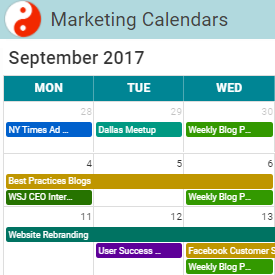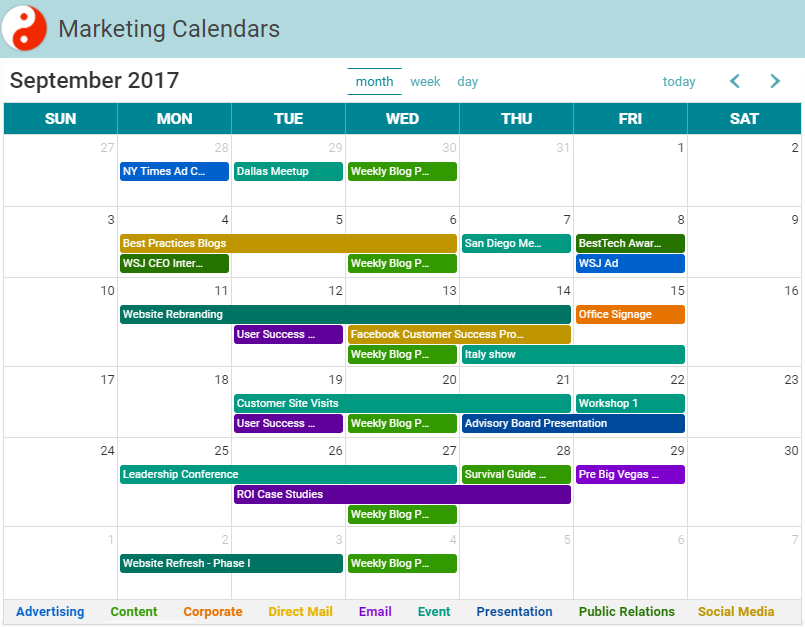Marketing Calendar Software Best Practices for Advanced Marketing Teams

It’s no secret that a marketing calendar is a must have for any marketing team. But, unless the scope of your marketing effort is limited, creating a marketing calendar takes more thought than just listing your programs on a monthly calendar and keeping them updated.
For a small marketing team, a monthly calendar layout in Excel or Google sheets is just fine. For a marketing team with a broad range of programs, or more than a couple groups of stakeholders to keep informed, spreadsheets and other simple solutions fall short. An advanced marketing team has more information to convey to a larger variety of stakeholders, which necessarily requires marketing calendar software with more sophisticated capabilities – or a lot more work.
This post details best practices for marketing calendar software solutions for larger, more advanced marketing teams. These best practices were learned across hundreds of customers and prospects with varying sizes and types of marketing teams. Not all marketing teams need all these best practices, but, all larger teams need some of these for their marketing calendar software.
Before we look at the best practices for marketing calendar software, let’s first understand why a marketing calendar is needed.
“Marketing calendars for advanced marketing teams must be configurable, automated and real-time.”
Understanding Why Marketing Calendars Are Needed
The most common need for a Marketing calendar is to answer the question “What is marketing doing?” This seemingly simple question is actually a complex series of questions. Outside of smaller operations, “What is marketing doing?” actually means “What is marketing doing for me?” Meaning, what is marketing doing for my product, my region, my division, etc.
Therefore, marketing teams have to answer not just a simple, general question about what they’re doing, but instead answer a series of questions across multiple audiences related to multiple products, regions, channels, strategic focuses, etc. Marketing must also answer this question from both a high level big picture view down to a tactical view, depending on the audience.

Simple, one-dimensional marketing calendars are insufficient for more complex marketing teams. Marketing calendar software must be horizontally configurable to display programs across products, regions, channels and so forth, as well as vertically configurable to show different levels of marketing programs.
This is why simple, one-dimensional marketing calendars are insufficient for more complex marketing teams. Simple marketing calendar solutions either present not enough information for some audiences, or present so much information that stakeholders can’t find what they want. Likewise, producing a large number of tailored marketing calendars, and keeping them updated, is not tenable. The answer is a configurable, real time, marketing calendar that pulls from a repository of all marketing programs to satisfy the unique needs of each stakeholder.
Whether home grown, or a commercial product, the following are best practices to take into consideration when buying or building marketing calendar software.
Best Practice: Instant Updates
Marketing Calendars Must Be Updated in Real Time
More of a mandate than a best practice, all marketing calendars must always be up to date. Worse than having no marketing calendar at all is having a calendar that shows out of date or incorrect information. If no calendar exists, stakeholders will seek out program information and likely get the most current data (unfortunately, at the expense of bugging you or your team). If a calendar exists but is not current, stakeholders easily assume the programs, dates and other data are correct, which leads to big problems. Similarly, if a program is included in multiple marketing calendars, the details for that program must be the same on all calendars.
To keep multiple marketing calendars up to date, slave each calendar to a common repository of program information. Store details about each program in the central repository, not in the calendar itself. This way, multiple calendars share the same data, there is only one ‘master’ record that needs to be updated, and all marketing calendars are always up to date. Yes, this requires some technical work if you are going to build it yourself. However, publishing multiple standalone marketing calendars on a regular basis is a recipe for disaster. Even if the calendars are kept in a central intranet or Sharepoint site, continuously updating many calendars is both time consuming and risky.
Eliminate this risk and labor by investing up front in a marketing calendar software architecture that ties a front end calendar display to a back end repository, and all marketing calendars will always be up to date.
Best Practice: Horizontal Configurability
Multiple Marketing Calendars for Multiple Stakeholders
Because marketing serves many stakeholders, each with their own related set of marketing programs, marketing calendars must be horizontally configurable. Then, the stakeholder or marketing team can easily configure individual marketing calendars to show select sets of programs according to need. For instance, you may need a calendar to show only events. Or, you may want a calendar to show only programs for a certain region, or division, or product. This demands that your marketing calendar software be configurable, allowing it to display only the programs of interest to each stakeholder.
To deliver horizontal configurability, work from the front end and the back end of your marketing calendar software. On the front end, your marketing calendar software must have a configurable interface to select different sets of programs. This could be as simple as preset filters that list the necessary options for product, region, division, or whatever is important to your audience. Or, your interface could be more powerful, like a simple query builder that lets the user create their own Boolean filter conditions, like all programs that are in region X AND are this channel OR that channel.
On the back end, diligently categorize and record every program so your filters or query builder have a consistent data repository to pull from. It is imperative that you have a consistent set of categories and data options to make this work. In the database world this is known as data integrity. In practice, this means that you can’t label a program as a ‘trade show’ and expect a filter that is looking for ‘events’ to find it.
Decide on your categories, match your filter mechanisms to those categories and values, and record your programs consistently. Then, let your stakeholders select the data they need for their personal marketing calendar.
Best Practice: Vertical Configurability
Marketing Calendars for The Big Picture and The Detailed Plan
Just as marketing calendar software must be horizontally configurable to display programs across products, regions, channels and so forth, it must also be configurable to show different levels of marketing programs. For simplicity, consider marketing output in a vertical hierarchy. Major campaigns are at the top, such as branding, or customer retention. Underneath a major campaign may be many programs, such as emails, advertising or content creation. Underneath each program may be many tasks, such as copy drafts, creating artwork or procurement. Different audiences require information from different levels of this hierarchy in their marketing calendar.
For instance, a marketing calendar for senior executives and high level planning requires big picture items, like major campaigns or product launches, but certainly should not include detail items like the third outreach email in a nurture track. Conversely, a team delivering a major product launch will care about the lower level details. Their marketing calendar should display details down to the task level so progress can be monitored and work can be coordinated, but their calendar should not show other major campaign information.
Letting your stakeholders determine which levels of programs to display in their marketing calendar requires vertical configurability. The same front end solutions discussed for horizontal configurability work for vertical configurability. On the back end, your programs need another dimension of categorization to allow the front end to select programs by hierarchy level. Categorizing programs as level 1, 2 or 3, or campaign, program, or task, or create your own concept of program hierarchy.
Best Practice: Multiple Formats
Marketing Calendars Need Not Be a ‘Calendar’
A monthly wall calendar layout is a simple, familiar format for a marketing calendar, but this format does not serve all use cases well. Similarly, a quarterly or yearly format that conveys the big picture is also not always the best format. Offering a combination of weekly, monthly, quarterly and possibly yearly calendar views is a solid starting point for your marketing calendar. But, even combined, these typical calendar formats still don’t deliver optimum utility.
For example, if a stakeholder wants to see how many webinars are planned, scanning multiple months or quarters looking for webinars is a poor solution. For this, and many other use cases, a sortable table format is a much better option. Producing table based views of the same programs shown in a traditional monthly marketing calendar, slaved to the same central repository of marketing programs, is an ideal way to provide stakeholders richer information when required.
Additionally, other display formats like pivot table formats grouping programs into swim lanes is more useful than either a monthly calendar or table view for certain use cases. So, when planning your marketing calendar software, don’t limit your thinking to just a monthly or weekly calendar view. Think in terms of multiple views of the same data to turn that data into the most easily consumed information, and don’t limit your marketing calendar software front end to just a ‘calendar.’
Best Practice: Make Marketing Calendars Two-Way
Allow Stakeholders to Update Marketing Calendars
Primarily, you want only your marketing team to add or change the information that populates your marketing calendar software. Sometimes, though, you may want people outside of marketing to update the marketing calendar. For instance, you may want members of your product team to adjust programs which they own. Or, you may want contractor or agency personnel to enter or adjust PR events. New programs and updates from outside groups can always be funneled through your marketing team, and a team member can update your program data repository, but, this wastes cycles and introduces delays.
Avoid the wasted cycles and delays by granting trusted stakeholders the ability to update programs directly. Either grant trusted stakeholders access to the program data repository directly, or through the calendar itself.
The simplest solution is to allow trusted personnel to update the program repository directly. But, this introduces a data security risk. Ideally, segment data repository access such that users can only see and update controlled sets of programs. A more sophisticated solution is to allow updates directly through the calendar interface. If the calendars use preset filters, this limits the risk of data ‘mismanagement’ to whatever data a particular filter covers.
Whichever method you choose, enrolling trusted stakeholders to update program data both makes them more invested in content and quality of your marketing calendars, and lessens the burden on your team.
Sophisticated Marketing Calendar Software for Sophisticated Marketing Teams
No matter the format, every marketing team must have a marketing calendar. As the sophistication of your marketing team, programs and stakeholders grows, so do the demands on your marketing calendar software. If that software is a spreadsheet or other basic platform, your team will invest more and more cycles to make your marketing calendars serve their purpose. Eventually, manually maintaining multiple marketing calendars based on these platforms will fail. Before that happens, consider these best practices and your own requirements and build or buy marketing calendar software that gives your team, and your stakeholders, richer, configurable, real time marketing calendars that satisfy everyone with much lower investment and risk.
Jim Burleigh
Latest posts by Jim Burleigh (see all)
- Marketing Calendar Software Best Practices for Advanced Marketing Teams - November 1, 2017
- Marketing Project Management Software vs. Generic Project Management Software - December 8, 2015
- Adopting Agile Marketing | Take an Easier Path - November 16, 2015
